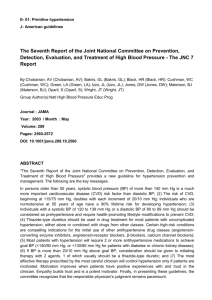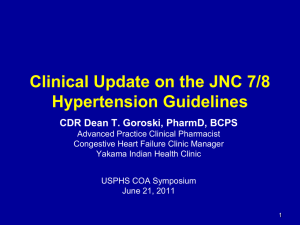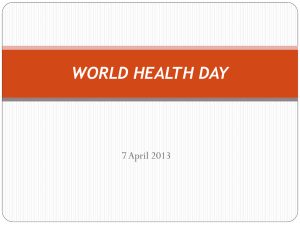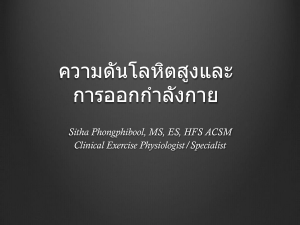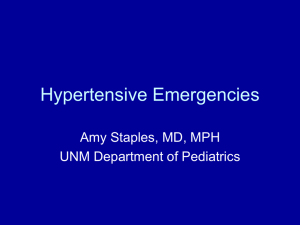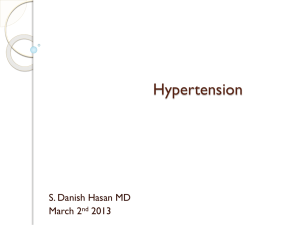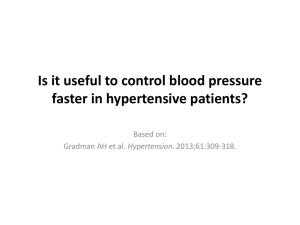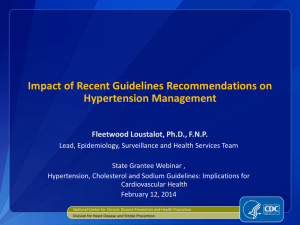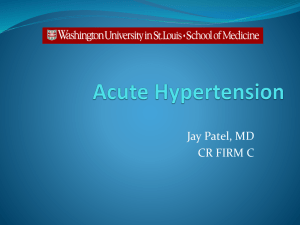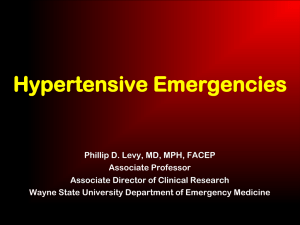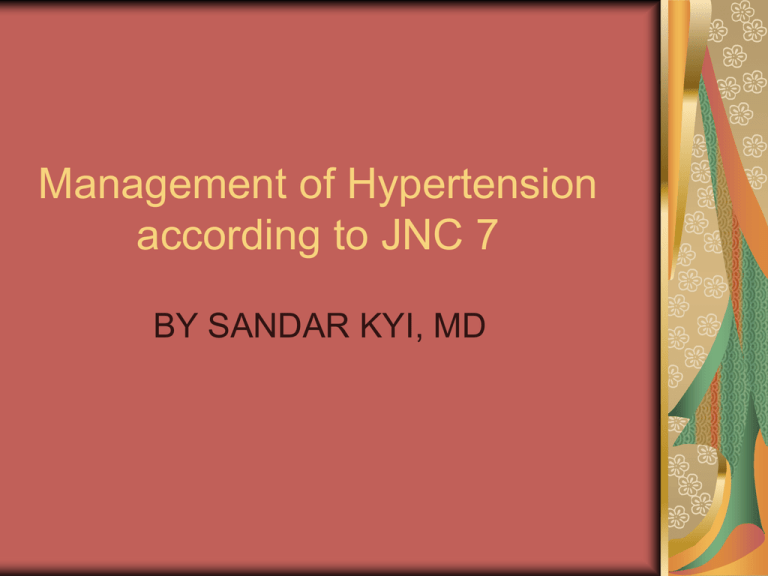
Management of Hypertension
according to JNC 7
BY SANDAR KYI, MD
Introduction
Hypertension is one of the most common
worldwide diseases afflicting humans.
Because of the associated morbidity and
mortality and the cost to society,
hypertension is an important public health
challenge.
In the US: Forty-three million people are
estimated to have hypertension
Introduction
Hypertension is the most important
modifiable risk factor for coronary heart
disease (the leading cause of death in
North America), stroke (the third leading
cause), congestive heart failure, end-stage
renal disease, and peripheral vascular
disease. Therefore, health care
professionals must not only identify and
treat patients with hypertension but also
promote a healthy lifestyle and preventive
strategies to decrease the prevalence of
hypertension in the general population
Introduction
Generally, the higher the blood
pressure, the greater the risk.
Untreated hypertension affects all
organ systems and can shorten one's
life expectancy by 10 to 20 years.
Introduction
The question is, what are the barriers
to the management of hypertension
according to JNC 7?.
Hypothesis
It is a hypothesis that barriers to the
effective management of patient with
uncontrolled hypertension include
patient management time constraints,
physician practice patterns,
drug adverse effects, and
patient specific factors such as lack of
adherence to therapy, limited access to
care, financial barriers related to the cost of
medications & lack of knowledge about the
seriousness of uncontrolled hypertension.
Methods
Random chart reviews of 200 patients out
of 500 charts those are following in FCC of
RCRMC for hypertension from 2000-2006.
Sex – F:M 157:43
Race – Hispanic : Non-Hispanic
115 : 85
Smoker : Non Smoker - 58:142
Inclusion Criteria : pt with prehypertension, HTN stage 1,stage 2
according to JNC 7.
Methods
All charts were reviewed following factors:
- Demographic factor: age, sex, culture
background, first language
-co-morbidity: hypercholesterolemia, IHD,
diabetes
outcome of BP treatment:
1. acute coronary event (CP, angina, MI,CHF, bypass surgery)
2. stroke (TIA, CVA both ischemic and hemorrhagic)
3. BP whether reached goal BP or not
JNC VII report recommendations
Initial therapy based on the JNC VII report recommendations
is as follows:
Prehypertension (systolic 120-139, diastolic 80-89): No
antihypertensive drug is indicated. (f/up BP measure within 1
yr).
Stage 1 hypertension (systolic 140-159, diastolic 90-99):
Thiazide-type diuretics are recommended for most. ACE
inhibitor, angiotensin II receptor blocker (ARB), beta-blocker,
calcium channel blocker, or combination may be considered.
Stage 2 hypertension (systolic more than 160, diastolic more
than 100): Two-drug combination (usually thiazide-type
diuretic and ACE inhibitor or ARB or beta-blocker or calcium
channel blocker) is recommended for most.
For the compelling indications, other antihypertensive drugs
(eg, diuretics, ACE inhibitor, ARB, beta-blocker, calcium
channel blocker) may be considered as needed.
JNC 7 Reference Card
JNC 7 Reference Card
Number of patients with HTN who
f/up in FCC
Number of patients with HTN who
did not reach goal BP
Complication in non-compliant
patients
Complication in patient whose Dr
not following JNC 7
Complication in patients who did
not take med: due to SE
Complication in patients who
reached goal BP
% of Acute Coronary Event
Complication
Numbers of patients with comorbidity
In pts who reached goal BP - 18
(25%)
In pts who were non-compliant – 34
(52%)
In pts who didn’t take med: due to SE
– 10 (32%)
In pts whose Dr not following JNC 715 (47%)
Numbers of patients with comorbidity
Discussion
Thus, according to this study, patient
non-compliant had been identified as
one of the main reasons that BP
therapy fails.
Drug adverse effects have also been
identified as a factor related to
physician prescribing pattern of
hypertensive medications.
Discussion
Other findings seem to suggest that
physicians are familiar with the JNC 7
guidelines for treating HTN but do not
implement this knowledge into their
everyday practice.
BP is one of the contributing factor to
get complication but other comorbidities (high cholesterol, DM ) can also
contribute to complications.
Conclusion
This study clearly demonstrates that
positive association between
uncontrolled HTN & complication (such
as cardiovascular disease , CVA,).
The finding of this study provide
useful information for designing
effective physician interventions for
the management of patients with
uncontrolled HTN.
Limitations of Research Study
Small sample sizes with 6yrs duration.
Didn’t review patient cultural background,
educational status, BMI, smoking history
details, control of diabetic, & control of
hypercholesterolemia.
Also not mentioned Duration of Physician
time spent with pt. Usage of language
interpreter if pt doesn’t speak English as
first language.
Recommendation
Further extensive study to include following
factors:
patient cultural background, educational
status, BMI, smoking history details, control
of diabetic & control of
hypercholesterolemia.
Duration of Physician time spent with pt.
Usage of language interpreter if pt doesn’t
speak English as first language.
References
Barriers to Blood Pressure Control
G. Divakara Murthy
Archives of Internal Medicine
E-medicine HTNSat Sharma, MD,
FRCPC, FACP, FCCP, DABSM, Program
Director, Associate Professor, Department
of Internal Medicine, Divisions of
Pulmonary and Critical Care Medicine,
University of Manitoba; Site Director of
Respiratory Medicine, St Boniface General
Hospital
The National High Blood Pressure
Education Program
Thank you!

